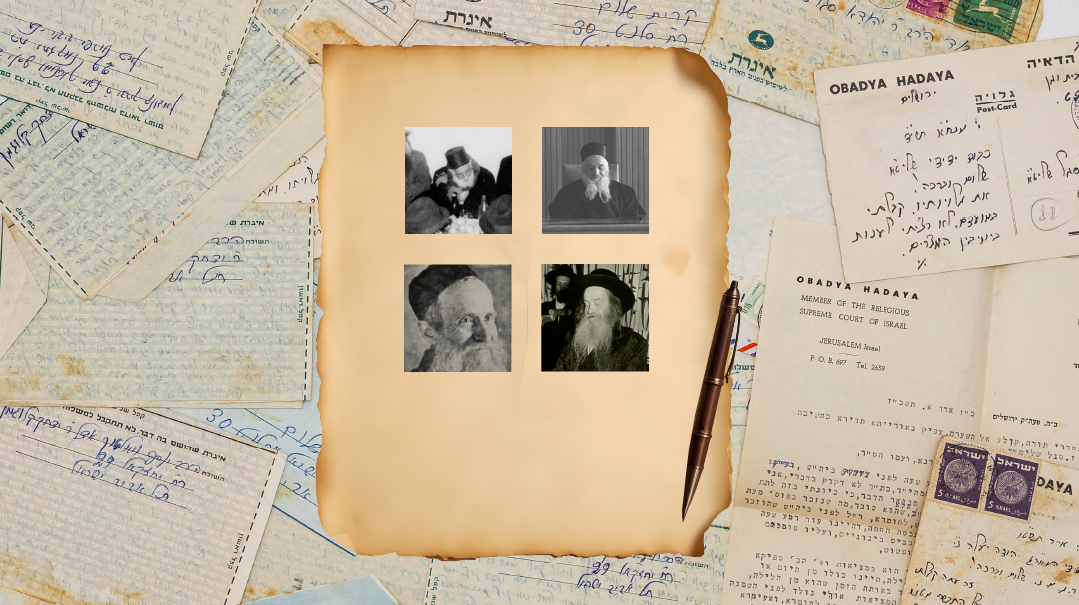Paper Trail
| July 9, 2024A treasure trove of secret letters from Tel Aviv’s cadre of hidden mekubalim

Photos: Elchanan Kotler, Mishpacha archives
A treasure trove of unpublished letters written and received by the secret mekubalim of Tel Aviv tells a lot about life in the ’50s and ’60s, but also sheds light on the spiritual struggles of the Streetsweeper, the Shoemaker, the Painter, the Milkman, and the famous rabbanim who held their secrets, as they all grappled with visions of the Upper Worlds while living in the hotspots of hedonism
HE locks the door behind me, opens the safe, and takes out the treasure: Dozens of stamped envelopes scatter across the office desk, and the small room seems to fill with light.
I carefully pick up a single envelope. It seems to contain a random letter between friends. But then I read the following lines:
“It’s been a long time since I have seen him, not while awake and not in a dream, and I yearn to see him and to hear good tidings from him… and also which good news and which chiddushei Torah he has heard from Eliyahu Hanavi zachur latov….”
The letter is signed simply “Yosef Waltuch,” but after reading its content, I begin to shiver. Rav Yosef Waltuch was one member of the famed group of hidden tzaddikim and mekubalim who lived in Tel Aviv in the mid and late 1900s. Which of his colleagues was he talking about, who was zocheh to learn Torah straight from Eliyahu Hanavi?
The answer to that, we’ll probably never know. But that doesn’t stop me from perusing dozens, up to hundreds, of notes and letters — correspondences between the secret kabbalists of Eretz Yisrael who were privy to the spiritual workings “behind the curtain.”
Rav Yosef Waltuch, known as the “Streetsweeper” because of his municipal day job, lived alone in a little hovel without a proper address, so the hundreds of petitioners, rabbanim, rebbes and other mekubalim would mail their correspondences to the homes around Tel Aviv where he would regularly eat his Shabbos seudos. And one member of such a family, who insists on remaining anonymous so as not to attract attention to the collection in his possession, let me take a peek into his treasure trove.
My acquaintance is probably not alone: The children and grandchildren of other families who received Rav Waltuch’s mail probably also possess some of Reb Yosef’s correspondences — and there were undoubtedly many letters that never reached their destination at all. (These collection proprietors have good reason to remain anonymous: During the funeral of one of the mekubalim of the last generation, his house was ransacked and all letters, documents and mementos were taken.)
Reb Yosef didn’t talk much, and even in shul he’d make himself invisible. But one Shabbos at the beginning of June in 1981, he stood up in Tel Aviv’s Beit Knesset Hagadol and asked for an aliyah, telling the gabbai, “I need to make a Mi Shebeirach.” When the gabbai asked for the name, he announced, “Menachem ben Chasya,” and everyone realized he was talking about Prime Minister Menachem Begin. The next day, Israel bombed Iraq’s nuclear reactor.
That was just one of thousands of Yosef Waltuch’s mofsim, yet he wasn’t alone. It was as if for many decades, Tel Aviv’s cluster of hidden tzaddikim were all on call behind the scenes.
They came from different places — some from Europe, others from Eastern nations — and each one concealed himself in a different way: There was the leader of the group, the Shoemaker, Rav Moshe Yaakov Ravikov, who passed away in the fall of 1966; the hidden tzaddik Rav Hillel Simchon; Rav Avraham Fish, known as the “Floor Layer” or “King of the Crazies,” yet whose blessings changed people’s lives; Rav Yehuda Patilon, known as the “Painter;” and Rav Ezra Eliyahu HaKohen and his son Rav Chaim Kohen, a Tel Aviv dairy worker known as the “Milkman” and the last of the group to pass away (in 2019).
Oops! We could not locate your form.







